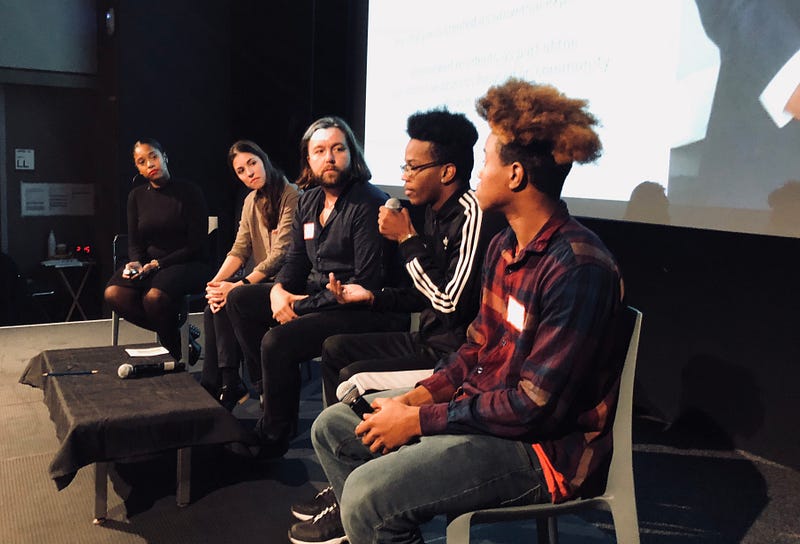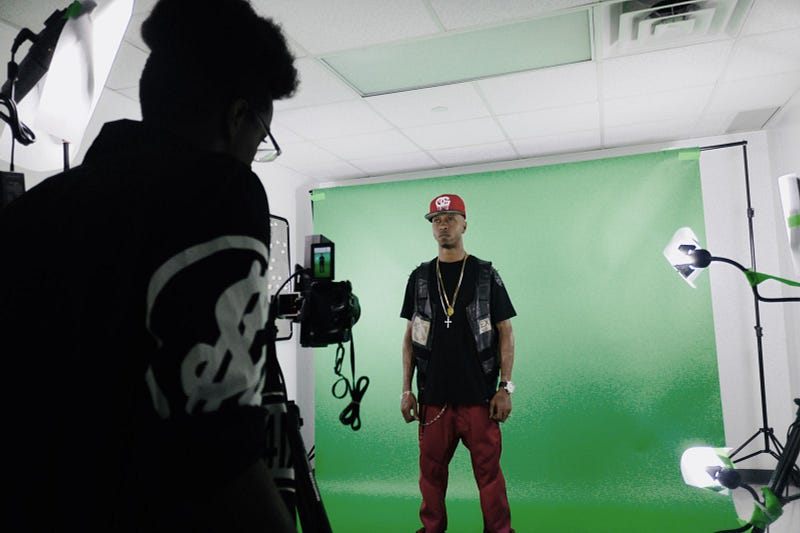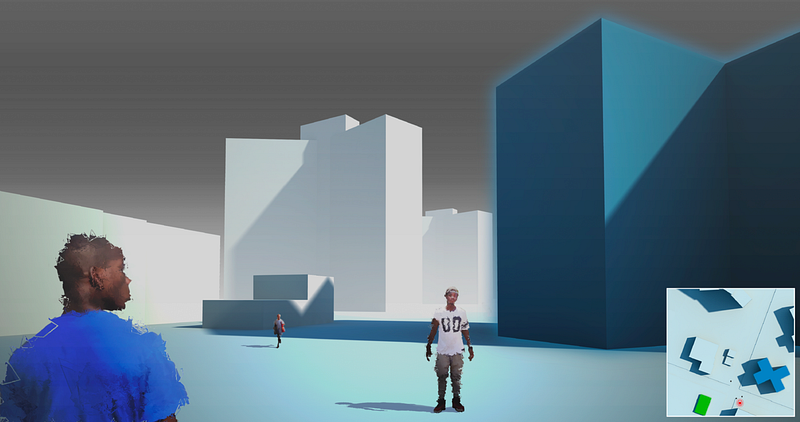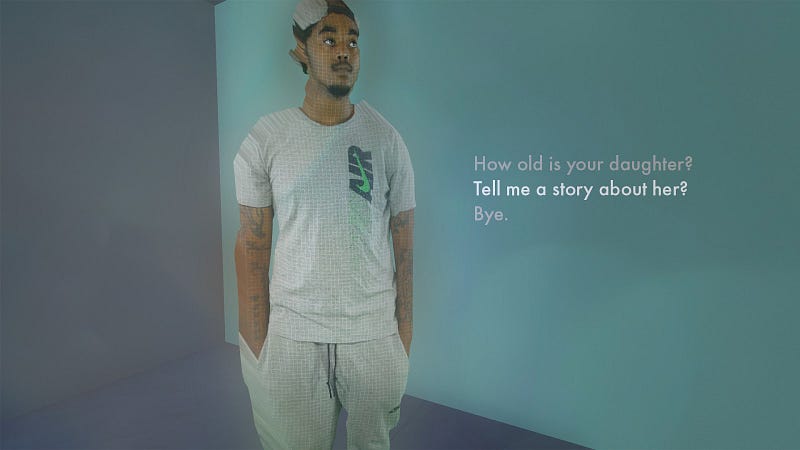
An interview with Nicholas Pilarski and Sarah Bassett
As part of our series related to the Collective Wisdom field study, we present an in-depth look into Fireflies: A Brownsville Story docu-game in this interview by Katerina Cizek.
 Left to
right: Jasmine Bowie, Sarah Bassett, Nicholas Pilarski, Rayquan Graham, and Adrian Richardson
Left to
right: Jasmine Bowie, Sarah Bassett, Nicholas Pilarski, Rayquan Graham, and Adrian Richardson
Fireflies came together through a collaboration between arts collective Peoples Culture and Brownsville Community Justice Center, an initiative supporting local youth in the predominantly Black and Latinx neighborhood of Brownsville in Brooklyn, New York.
We talked to Nicholas Pilarski and Sarah Bassett — media-makers from Peoples Culture who are white — about the project and their commitment to a co-creative process that evolves from within communities.

How do you define co-creation?
Pilarski: For us, co-creation is simply finding people we want to work with, who we can learn from.
Bassett: I think what’s essential when we talk co-creation is experiencing a mutual sense of humanity. It’s not my perspective. It’s not someone else’s perspective. It’s a shared perspective. I think it’s very easy to tell the story of another. I have ethical concerns with that work.
Could you tell us more about the co-creation process in Fireflies?

Pilarski: We went to the Brownsville Community Justice Center in New York City, where I met Ray Graham, who wanted to address the negative perceptions of his community. Ray and a number of other young people wanted to create a video game to explore these issues because they felt that their community wouldn’t really care about a film or about an animation. We set up a lab to train young people to learn the foundations of video game and 3D design. The lab is still going, in fact. It is a permanent fixture in Brownsville.
Bassett: We tried to partner with different technology companies, places like DepthKit. The participants in the lab are trained on RED cameras and in Unity, and use industry standard technologies, which is extremely important because we want them to be able to go out and be competitive in the industry.
Can you describe the user experience of Fireflies?

Pilarski: You play as a male protagonist and a female protagonist. You swap between them. A, B, A, B. They’re both aspiring photojournalists, which gives you the narrative reason to talk to a bunch of people in the neighborhood. We created a photo metric so you can take a picture, post it on Instagram for the video game. You can begin to share your experiences. You’re playing the documentarian in the video game, but then you have some life events that occur and that’s the narrative thread. Throughout that, you have to do puzzles, to find what it means to be someone from Brownsville.
Bassett: Within the game, we brought in over 100 different community members using DepthKit, where they’re physically in the game. As you navigate through the game, you’re interviewing different community members.
Pilarski: Due to discriminatory disinvestment in Brownsville over many decades, the neighborhood has experienced a dismantling of its social and physical capital. Many residents are forced to align with a gang connected to their housing development. The result of this is that many residents, particularly youth, cannot cross territorial divides. Some are unable to move from one block to the next based on invisible borders. So, I think there was this huge desire for young people to be able to virtually cross into another part of their community that they can’t physically walk into to hear stories of their fellow residents.
How do you plan to launch the game?
Pilarski: The hope is for two launches. The first launch is in Brownsville. It will be played in different areas simultaneously, including Brownsville Community Justice Center, with facilitated conversations. You play the game, you go into a conversation. You play the game, you facilitate that conversation. We’re very keen on the limitations of media and we believe in people very much. We think that this is a way to stimulate that conversation. We have multiple community centers who have helped us throughout. And we’re working right now to have kiosks set up in lobbies of the NYCHA housing developments in Brownsville this fall.
How can people outside of the community experience this game?
Bassett: That is the second part: We hope to take it beyond the neighborhood. We were invited to a conference in Athens, Greece, in 2018. The Stavros Niarchos Foundation brought the Fireflies team out and we all gave a presentation on the project. We’d love to be able to do more of that type of thing. Whether that’s film or media festivals or a range of different types of environments where we can show this and have the community participants and the youth really be the ones who are presenting it, both in New York City and more broadly.
Fireflies project team members include: Sarah Bassett, Jasmine Bowie, John Bryant, Rayquan Graham, Destiny Kippins, Nicholas Pilarski, Candace Oliver, Adrian Richardson, Julie Taylor, Brownsville Community Justice Center, Brownsville Tech Lab, and Peoples Culture.
This article is part of Collective Wisdom, an Immerse series created in collaboration with Co-Creation Studio at MIT Open Documentary Lab. Immerse’s series features excerpts from MIT Open Documentary Lab’s larger field study — Collective Wisdom: Co-Creating Media within Communities, across Disciplines and with Algorithms — as well as bonus interviews and exclusive content.
Immerse is an initiative of the MIT Open DocLab and The Fledgling Fund, and it receives funding from Just Films | Ford Foundation and the MacArthur Foundation. IFP is our fiscal sponsor. Learn more here. We are committed to exploring and showcasing media projects that push the boundaries of media and tackle issues of social justice — and rely on friends like you to sustain ourselves and grow. Join us by making a gift today.